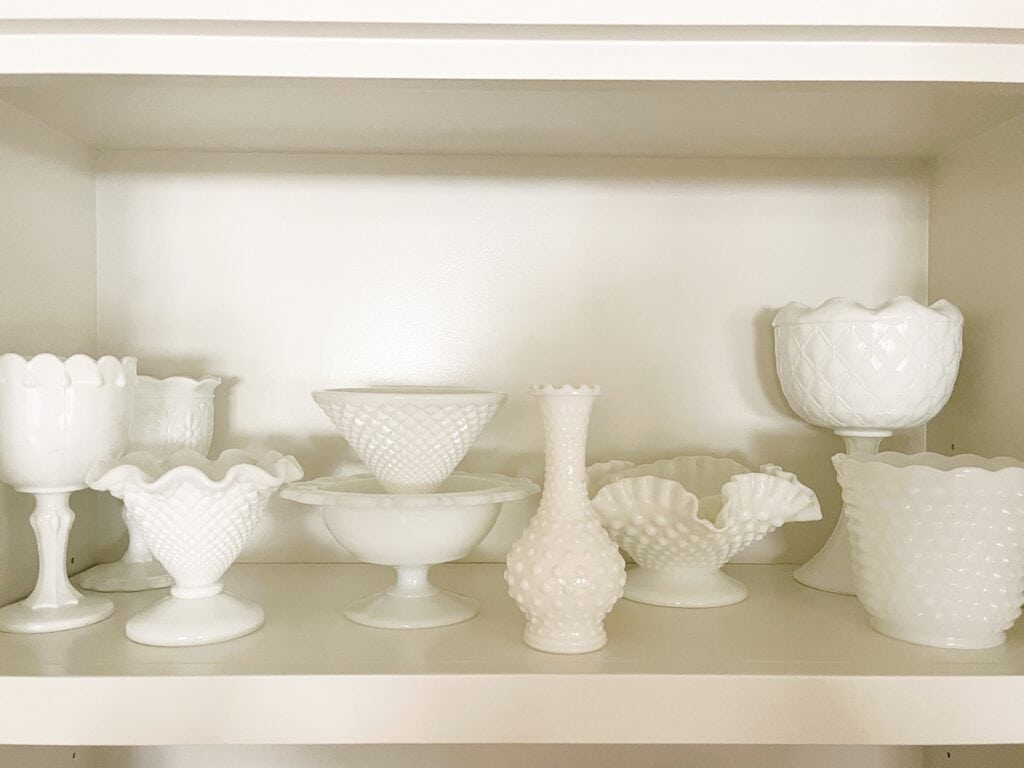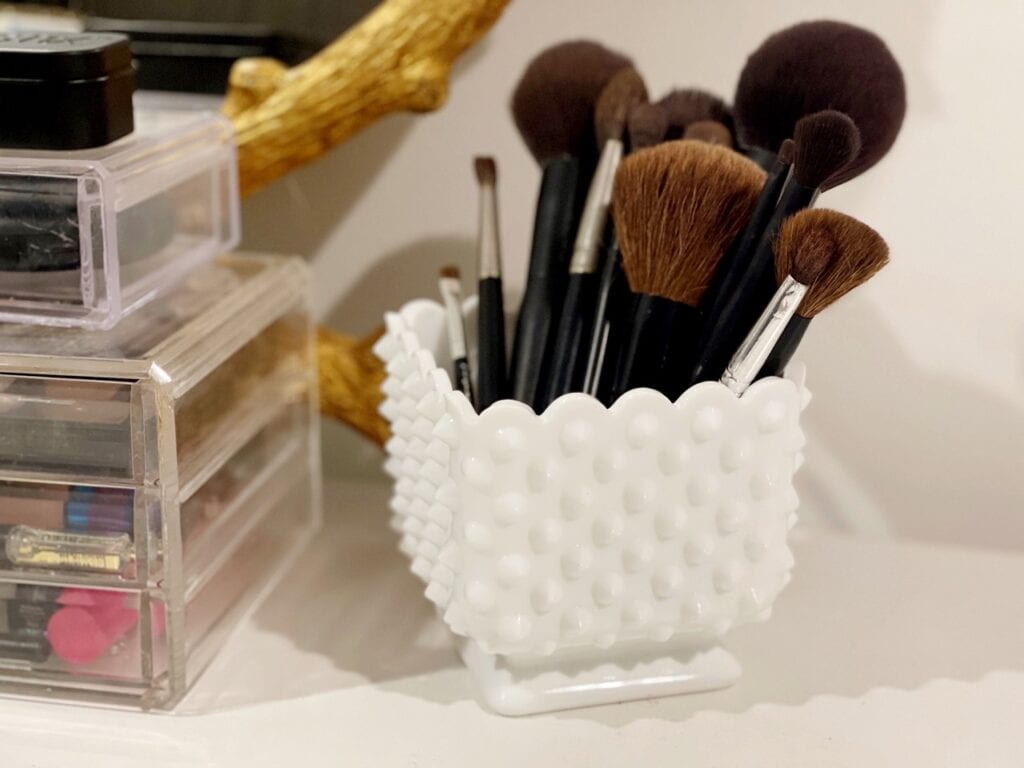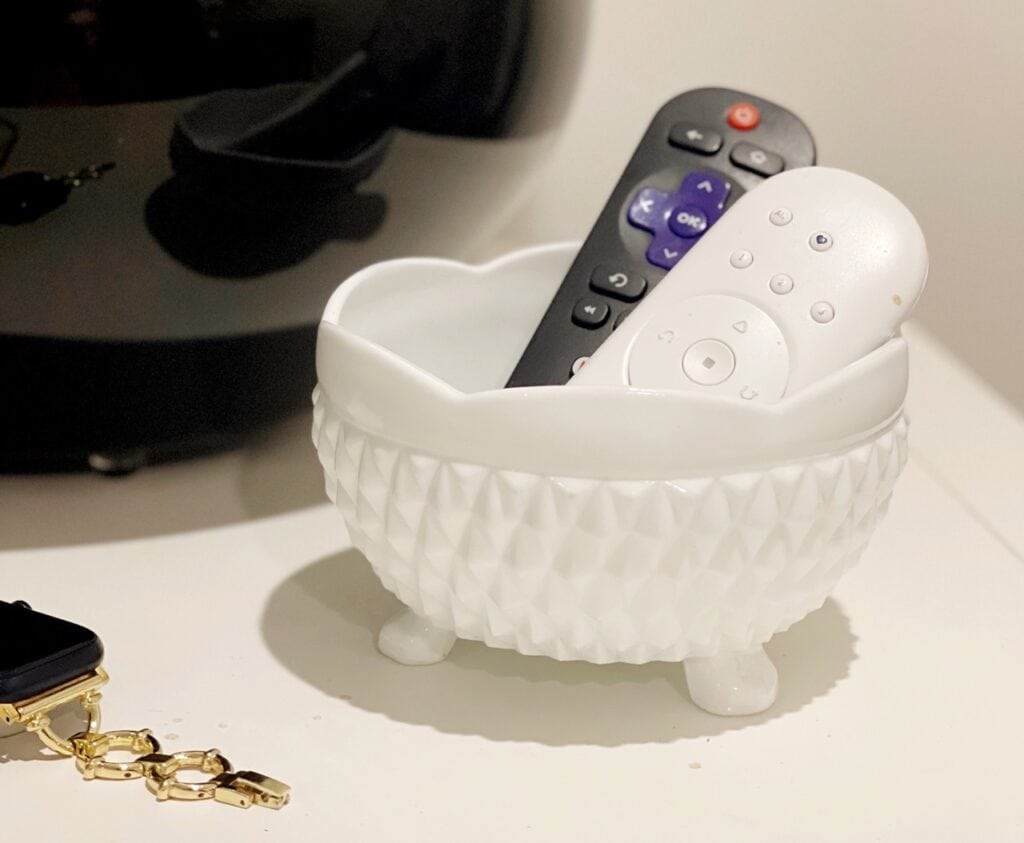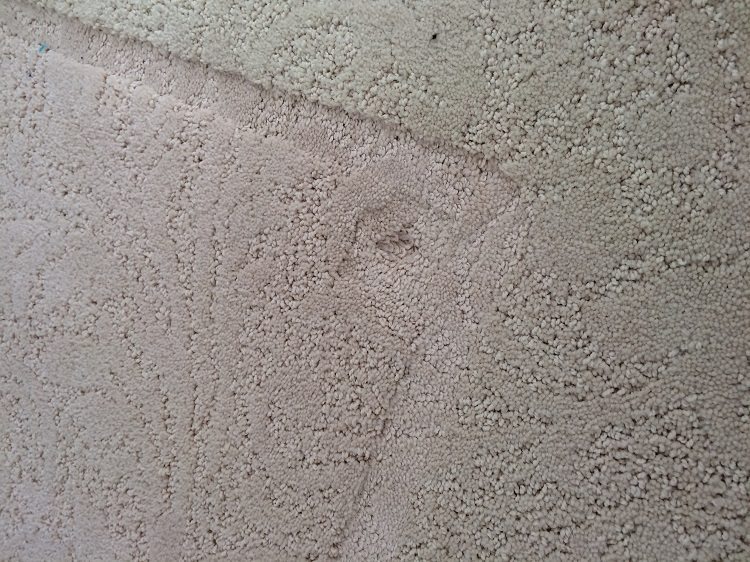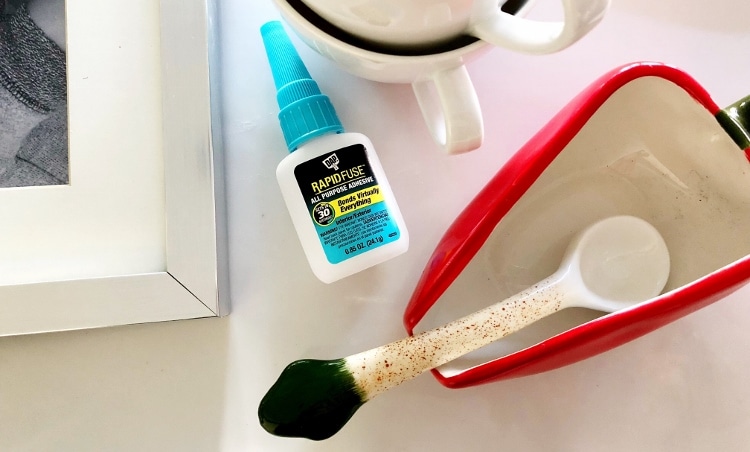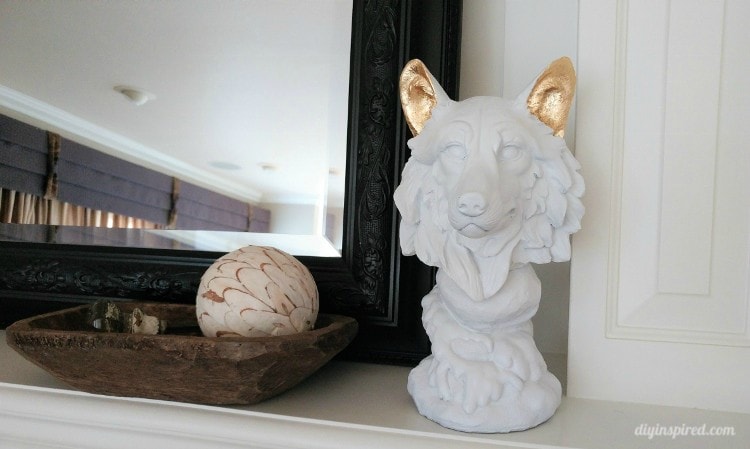A Guide to Collecting, Buying, and Selling Milk Glass
Everything You Need to Know About Collecting, Buying, and Selling Milk Glass
Is milk glass worth any money? I see it all the time. Is it worth collecting? Can I make money from selling it? Here is a guide to collecting, buying, and selling milk glass.
What is Milk Glass?
Milk glass is a term used for opaque or translucent, milky white or colored glass, which can be blown or pressed into a wide variety of shapes. First made in Venice in the 16th century, this type of glass gained the height of its popularity during the Victorian era and again in the mid-20th century.
The main characteristic that gives milk glass its distinctive appearance is the addition of opacifiers such as bone ash, tin dioxide, or fluoride compounds to the glass formula, which make the glass appear more opaque and porcelain-like. While the most common color for milk glass is white, it can also be produced in pink, blue, black, yellow, and green. These pieces often feature a smooth, glossy finish.
Milk glass is used for a variety of items including vases, bowls, figurines, and was especially popular for dishware and decorative lamps. Collectors often value older pieces for their intricate designs and historical relevance. Milk glass pieces from certain periods, particularly those with unique colors or patterns, can be quite valuable and sought after in the antiques market.
Where Can You find Antique Milk Glass?
Antique milk glass can be found through various sources, each offering a unique range of items and experiences. Here are some popular places where you can hunt for these vintage pieces:
- Antique Stores – These are some of the most likely places to find a variety of milk glass. Antique stores often have knowledgeable staff who can provide valuable information about the age and origin of their pieces.
- Thrift Stores and Flea Markets – You can sometimes find milk glass at thrift stores, flea markets, and garage sales. These venues often offer lower prices, though finding valuable pieces can be hit-or-miss and requires a good eye.
- Online Marketplaces – Websites like eBay, Etsy, and Ruby Lane are great resources for finding milk glass. These platforms have a wide selection of items from different eras and at varying price points. You can also read descriptions and view photos before making a purchase.
- Estate Sales – Estate sales can be excellent places to find high-quality antique milk glass. Items at these sales often come from long-time collectors and can include rarer pieces.
- Auctions – Both online and physical auction houses sometimes feature lots that include milk glass. Auctions are a good place to find particularly rare or valuable items, although the prices can go higher depending on the bidding.
- Specialist Dealers and Collectors – Some antique dealers specialize in glassware, including milk glass. Connecting with these experts can lead to high-quality finds and they can offer specific advice and history about the items.
When hunting for antique milk glass, it’s helpful to have some knowledge about the marks, manufacturers, and styles that differentiate older, more valuable pieces from newer, less valuable reproductions. Always inspect pieces for signs of wear, age, and authenticity, such as markings from known manufacturers or characteristic features of antique milk glass.
How Can You Tell of Milk Glass is Real?
Determining the authenticity and quality of milk glass involves examining several aspects of the item. Here are some tips to help you identify whether a piece of milk glass is genuine and potentially valuable:
Manufacturer Marks
Many reputable manufacturers of milk glass left marks on their pieces. Identifying these marks can help ascertain the age and authenticity of the piece. Common marks include those from Fenton, Westmoreland, Imperial Glass, and others. These marks may be embossed, etched, or printed on the bottom or another discreet part of the item.
Quality of Glass
Older, high-quality milk glass tends to have a certain level of craftsmanship that is often visible in the details. Look for a smooth, glossy finish with even coloring. If the glass has a more translucent quality in some areas and opaque in others, it may be an indication of older, possibly handcrafted milk glass.
Design and Pattern
Familiarize yourself with popular patterns and designs from major manufacturers. Certain patterns or shapes can be indicative of specific eras or makers. For example, Fenton is known for hobnail patterns (raised bumps on the surface), while Westmoreland often produced pieces with lace edges.
Weight and Thickness
Older milk glass pieces are generally heavier and thicker than many newer reproductions. This is due to the materials and production methods used in earlier times.
Condition
While not necessarily an indicator of authenticity, the condition can tell you about the piece’s age and care. Older pieces might show signs of wear like slight discoloration or scratches, which can actually authenticate their age and use.
UV Light Test
Milk glass made before the 1940s sometimes fluoresces under a UV or black light due to the presence of certain materials like manganese. This can be a helpful test, although it’s not foolproof since not all old pieces contain these materials.
Consult Books and Online Resources
Reference books and online forums can provide a wealth of information on milk glass. Using these resources to compare your item with documented pieces can be very helpful.
If you’re considering purchasing a piece and want to ensure it’s authentic, or if you’re unsure about the piece you have, consider consulting with an expert in antique glass. Their expertise can be invaluable in confirming the authenticity and value of milk glass.
Is Milk Glass Worth Any Money?
Yes, milk glass can be worth money, particularly older and rarer pieces. The value of milk glass depends on several factors, including its age, condition, rarity, manufacturer, and design. While common pieces of milk glass might not be particularly valuable, selling for just a few dollars, rarer items can sell for hundreds or even thousands of dollars. If you’re looking to buy or sell milk glass, it’s a good idea to do some research or consult a professional appraiser to get a better understanding of its potential value. Online auctions and sales platforms can also give you an idea of what similar items are currently selling for.
Here’s a brief overview of what might influence the monetary worth of a piece of milk glass:
- Age and Rarity – Older pieces of milk glass, especially those that are rare or were made in limited quantities, tend to be more valuable. Pieces from the 19th century or early 20th century often fetch higher prices, especially if they are from well-known manufacturers or have unique characteristics.
- Manufacturer – Certain manufacturers are highly sought after by collectors. For example, milk glass produced by Fenton, Westmoreland, or Imperial Glass can be more valuable. Items that still have their original marks or labels are often worth more because they can be easily identified.
- Condition – Like all collectibles, condition plays a crucial role in the value of milk glass. Items without chips, cracks, or significant wear are more desirable and thus command higher prices.
- Design and Pattern – Some patterns and designs are more popular among collectors and may command higher prices. For instance, intricate designs, unusual shapes, or items that are part of a series or collection can be particularly valuable.
- Market Demand – As with any collectible, the current market demand can significantly affect value. Trends in collecting can change, and what is highly prized one year may not be the next.
Common Price Ranges for Milk Glass
Common Items: Everyday pieces of milk glass, such as simple vases, bowls, or plates, might sell for as little as $5 to $20 each. These are abundant and often picked up by casual buyers rather than serious collectors.
Mid-Range Items: More desirable items, such as those with popular patterns or from well-known manufacturers, can range from $20 to $100. Examples include Fenton Hobnail milk glass or pieces with original labels and markings.
High-End Collectibles: Rare and exceptional pieces, particularly large items or those from significant historical periods, can fetch several hundred dollars or more. For instance, a rare Fenton milk glass lamp or a piece with historical significance could sell for over $200 or even up to $500.
What is Fenton Milk Glass?
Fenton milk glass refers to the milk glass produced by the Fenton Art Glass Company, which was founded in 1905 in Martins Ferry, Ohio, by brothers Frank and John W. Fenton. The company moved to Williamstown, West Virginia, where it became one of the foremost producers of handmade art glass in the United States. Fenton is particularly noted for its significant contributions to the development and popularization of colored glass, including milk glass.
Fenton’s milk glass is typically very opaque with a creamy, smooth texture, often featuring a glossy finish that resembles porcelain. It was known for a variety of distinctive patterns.
What is Hobnail Milk Glass?
One of the most famous is the Hobnail pattern, which features a series of raised bumps across the surface. This became popular in the mid-20th century and remains one of Fenton’s most recognized designs in milk glass. In addition to patterns like Hobnail, Fenton also produced items with ruffled edges, intricate lattice work, and floral motifs, often incorporating vibrant colors with the white milk glass for a dramatic effect.
Where is the Best Place to Sell Milk Glass?
When it comes to selling milk glass, you have several options, each with its own advantages depending on the specific items you have and your goals for selling (such as whether you want a quick sale, best price, or an easy process). Here are some of the most effective places to sell milk glass:
Online Marketplaces:
- eBay: This is a popular choice for selling collectibles like milk glass because it has a large audience of collectors. You can set up an auction or a fixed price, which gives flexibility in how you sell.
- Etsy: Ideal for vintage and antique items, Etsy attracts buyers who are specifically looking for unique and collectible pieces.
- Ruby Lane: Known for antiques and collectibles, Ruby Lane is a more niche platform that attracts serious collectors who may be willing to pay higher prices.
Antique Stores or Consignment Shops:
Selling through an antique store or on consignment can be a good option if you prefer a hands-off approach. Stores will handle the display and sale, but they will take a percentage of the sales price.
Antique Shows and Flea Markets:
Setting up a booth at an antique show or flea market can reach buyers who are passionate about finding unique items. This method allows you to control pricing and interact directly with buyers.
Auction Houses:
For particularly valuable or rare pieces of milk glass, consider selling through an auction house. They can target high-end collectors who may be willing to pay top dollar for rare items.
Social Media and Specialty Forums:
Platforms like Facebook Marketplace, Instagram, or specific collector groups can be excellent for reaching a targeted audience without the fees associated with traditional online marketplaces. Collector forums and groups specific to glass collecting can be a place to list your items where they are appreciated and valued.
Estate Sales:
For large collections of milk glass, holding an estate sale can be an effective way to sell directly to the public.
Local Ads and Community Boards:
Listing your items in local classifieds or community bulletin boards can attract buyers, saving on shipping costs and hassles.
Tips for Selling Milk Glass
- Know Your Product: Research the specific types of milk glass you have. Some patterns and manufacturers are more sought after than others.
- Set the Right Price: Check completed sales on platforms like eBay to understand what similar items are selling for.
- Take Good Photos: Clear, well-lit photos that show any unique details and condition of milk glass will help attract buyers.
- Provide Detailed Descriptions: Be honest and thorough in your descriptions, noting any flaws and appealing features of your pieces.
Choosing the right venue depends on your individual circumstances, the nature of your milk glass collection, and how actively involved you want to be in the selling process.

